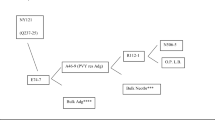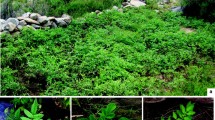Abstract
Volunteers from genetically modified (GM) potatoes may pose an environmental problem if allowed to grow in the field after the annual crop is harvested. We tested whether they are more likely to produce volunteers than non-GM potatoes. Specifically, we compared the number of volunteers, number of tubers per plant, tuber size, and their vertical distribution in the soil. More volunteer plants came from non-GM potatoes than from GM potatoes, but the number and size of tubers were similar between the two. Vertical distribution of the tubers differed significantly, with most non-GM tubers being found in shallower soil (<2 cm deep). Our results suggest that spontaneous GM volunteers may emerge and produce tubers to a degree similar to that of the non-GM plants. No viable volunteers emerged from GM tubers in the next growing season, probably deterred by winter frost and a period of low soil temperatures (below −2°C) at our study site. However, in regions with warmer climates, such GM volunteers may survive Winter and produce more plants the following year.





Similar content being viewed by others
References
Askew MF, Struik PC (2007) The canon of potato science: 20. Volunteer potatoes. Potato Res 50:283–287
Boydston RA (2004) Managing volunteer potato (Solanum tuberosum) in field corn (Zea mays) with carfentrazone-ethyl and dicamba. Weed Technol 18:83–87
Boydston RA, Seymour MD, Brown CR, Alva AK (2006) Freezing behavior of potato (Solanum tuberosum) tubers in soil. Amer J Potato Res 83:305–315
Boydston RA, Collins HP, Alva AK (2008) Control of volunteer potato (Solanum tuberosum) in sweet corn with mesotrione is unaffected by atrazine and tillage. Weed Technol 22:654–659
Celis C, Scurrah M, Cowgill S, Chumbiauca S, Green J, Franco J, Main G, Kiezebrink D, Visser RGF, Atkinson HJ (2004) Environmental biosafety and transgenic potato in a centre of diversity for this crop. Nature 432:222–225
Conner AJ (2006) Biosafety evaluation of transgenic potatoes: gene flow from transgenic potatoes. In: Huang S-C, Chen S, Lin C-Y (eds) Ecological and Environmental Biosafety of Transgenic Plants. Proceedings of International Symposium. Taiwan Agricultural Research Institute, Taichung, Taiwan, pp 127–140
Crawley MJ, Brown SL, Hails RS, Kohn DD, Rees M (2001) Transgenic crops in natural habitats. Nature 409:682–683
Ellis PJ (1992) Weed hosts of beet western yellows virus and potato leafroll virus in British Columbia. Plant Dis 76:1137–1139
Kang J-Y, Choi H-I, Im M-Y, Kim SY (2002) Arabidopsis basic leucine zipper proteins that mediate stress-responsive abscisic acid signaling. Plant Cell 14:343–357
Kapteijns AJAM (1993) Risk assessment of genetically modified crops. Potential of four arable crops to hybridize with the wild flora. Euphytica 66:145–149
Korea Meteorological Administration (2010) Climate data. http://www.kma.go.kr/gw.jsp?to=weather_main.jsp. Accessed 28 April 2010
Korean Statistical Information Service (2010) Statistical Database. http://kosis.kr/nsp/index/index.jsp. Accessed 27 April 2010
Love SL (1994) Ecological risk of growing transgenic potatoes in the United States and Canada. Amer Potato J 71:647–658
Lu B-R (2008) Transgene escape from GM crops and potential biosafety consequences: an environmental perspective. Collection Biosafety Rev 4:66–141
Lumkes LM, Beukema HP (1973) The effect of cultivation procedure on the liability to freezing of ground-keepers. Potato Res 16:57–60
Lumkes LM, Sijtsma R (1972) Mogelijkheden aardappelen als Onkruid in volggewassen te voorkomen en/of te bestrijden. Landb Planten 1:17–36
Lutman PJW (1977) Investigations into some aspects of the biology of potatoes as weeds. Weed Res 17:123–132
Matsuoka T, Kuribara H, Takubo K, Akiyama H, Miura H, Goda Y, Kusakabe Y, Isshiki K, Toyoda M, Hino A (2002) Detection of recombinant DNA segments introduced to genetically modified maize (Zea mays). J Agric Food Chem 50:2100–2109
Oh S-J, Song SI, Kim YS, Jang H-J, Kim SY, Kim M, Kim Y-K, Nahm BH, Kim JK (2005) Arabidopsis CBF3/DREB1A and ABF3 in transgenic rice increased tolerance to abiotic stress without stunting growth. Plant Physiol 138:341–351
Pérombelon MCM (1975) Observations on the survival of potato groundkeepers in Scotland. Potato Res 18:205–215
Spooner DM, McLean K, Ramsay G, Waugh R, Bryan GJ (2005) A single domestication for potato based on multilocus amplified fragment length polymorphism genotyping. Proc Natl Acad Sci USA 102:14694–14699
Thomas PE (1983) Sources and dissemination of potato viruses in the Columbia Basin of the northwestern United States. Plant Dis 67:744–747
Vanjildorj E, Bae T-W, Riu K-Z, Kim SY, Lee H-Y (2005) Overexpression of Arabidopsis ABF3 gene enhances tolerance to drought and cold in transgenic lettuce (Lactuca sativa). Plant Cell Tiss Org 83:41–50
Williams MM II, Ransom CV, Thompson WM (2005) Duration of volunteer potato (Solanum tuberosum) interference in bulb onion. Weed Sci 53:62–68
Wurr DCE (1977) Some observations of patterns of tuber formation and growth in the potato. Potato Res 20:63–75
Acknowledgements
This research was supported by grants from the KRIBB Research Initiative Program and the Crop Functional Genomics Center (CG3212).
Author information
Authors and Affiliations
Corresponding author
Rights and permissions
About this article
Cite this article
Kim, CG., Kim, D.Y., Moon, Y.S. et al. Persistence of Genetically Modified Potatoes in the Field. J. Plant Biol. 53, 395–399 (2010). https://doi.org/10.1007/s12374-010-9128-5
Received:
Revised:
Accepted:
Published:
Issue Date:
DOI: https://doi.org/10.1007/s12374-010-9128-5




